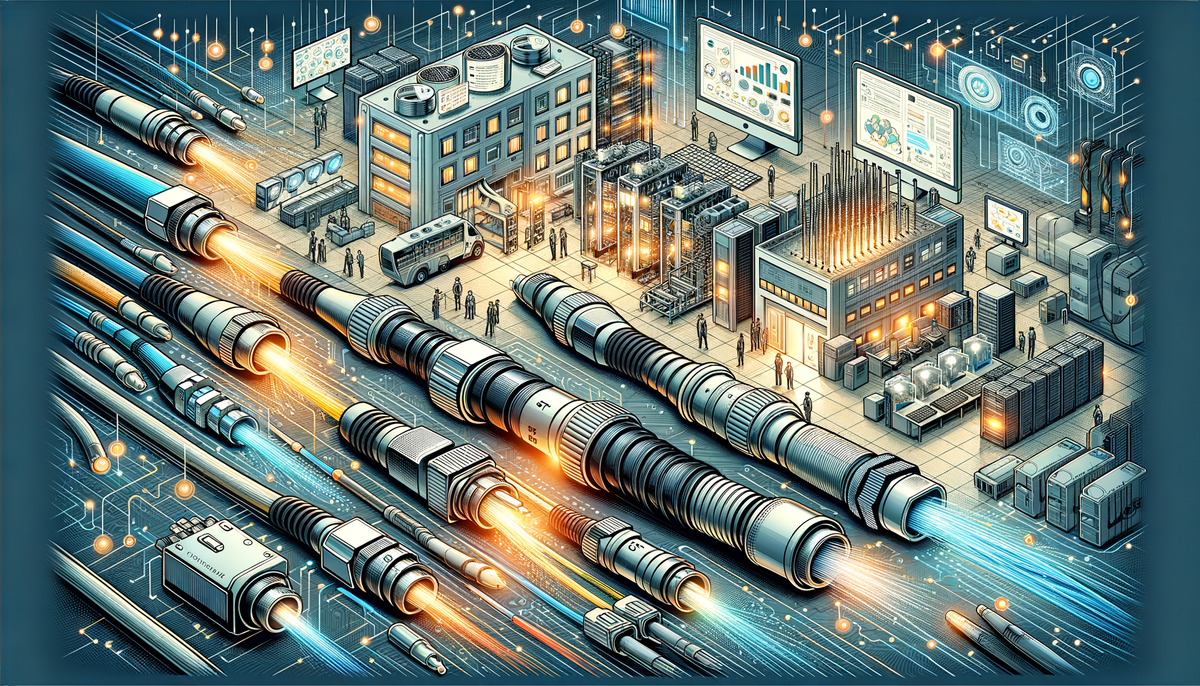Fiber Cable Connector Types: A Deep Dive into the World of ST, SC, LC, FC, and MTRJ Connectors
Learn about the different types of fiber cable connectors, including ST, SC, LC, FC, and MTRJ. Discover their unique features and applications, from home networks to data centers. Choose the right connector for optimal performance and reliability!

Fiber optic cables are super fast! They're used for the internet and moving big files quickly. But to connect these cables, we need special connectors. In this guide, we'll dive into the different types of fiber cable connectors, exploring their key features and how they're used in real life.
ST Connectors: A Sturdy Old Friend
ST, short for Straight Tip, is one of the oldest connectors. It's like a strong, reliable friend that's been around forever. You can use ST connectors for both single-mode and multi-mode fibers, which are different ways of carrying data.
Why ST Connectors Are Great:
- They're tough! The twist-and-lock system is super secure, so you don't have to worry about the connection coming loose. This makes them perfect for places where things get bumpy, like factories.
- Versatile: ST connectors can work with different types of fiber cables, so you have more choices.
Using ST Connectors:
ST connectors are often found in networking equipment in places like factories and server rooms. Imagine all those computers and servers connected with ST cables – that's how important these connectors are!

SC Connectors: Simple and Reliable
SC, or Subscriber Connector, is known for being easy to use. It's like a simple, reliable tool that just gets the job done. SC connectors are mostly used for moving data around, especially in telecommunications and computer networks.
Why SC Connectors Are Great:
- Easy to use: They have a simple push-pull mechanism, so you can easily plug them in and unplug them. No twisting or complicated steps.
- High quality: The connectors are designed to align the fibers perfectly, which means data travels smoothly and without any problems.
- Double the capacity: SC connectors can carry two fibers at the same time, so you can send more data!
Using SC Connectors:
You'll often find SC connectors in cable TV networks, where they connect your TV to the cable box. They're also used in fiber-to-the-home (FTTH) setups, bringing super fast internet directly to your house.
LC Connectors: Tiny But Mighty
LC, or Lucent Connector, is super small and compact. It's like a tiny superhero that packs a powerful punch! LC connectors are perfect for places where you need to connect lots of cables in a small space, like data centers.
Why LC Connectors Are Great:
- They're small! They're half the size of SC connectors, so you can fit more cables in a smaller area.
- Secure and easy to use: They have a latch mechanism, like an RJ-45 connector, which makes them easy to plug in and unplug.
- Super reliable: LC connectors are designed for high-speed networking, so you can be sure your data is moving quickly and without errors.
Using LC Connectors:
LC connectors are essential for data centers and server farms, where you need fast and reliable connections for all those servers.

FC Connectors: Built for Tough Times
FC, or Ferrule Connector, is built for strength. It's like a sturdy, reliable tool that can handle even the roughest conditions. FC connectors are used when you need a really secure connection that won't come loose, especially in places with lots of vibrations.
Why FC Connectors Are Great:
- Super secure: The threaded barrel ensures a strong and stable connection, which is perfect for places with lots of movement, like factories or construction sites.
- Vibration resistant: FC connectors are designed to withstand vibrations, so you don't have to worry about them coming loose.
- Precision connections: FC connectors are mostly used with single-mode fibers, which are perfect for long distances and high-speed data transmission.
Using FC Connectors:
FC connectors are often found in industrial and military applications where reliability and accuracy are crucial. Imagine them being used in robots, aircraft, or even satellites!

MTRJ Connectors: Small, Simple, and Smart
MTRJ, or Mechanical Transfer Registered Jack, is a compact connector that's easy to use. It's like a small, convenient tool that saves space and makes things easier. MTRJ connectors are great for home and office networks, where you want to reduce cable clutter.
Why MTRJ Connectors Are Great:
- Tiny size: They're smaller than traditional connectors, so they take up less space. This is super handy in tight spaces or when you have lots of cables to manage.
- Double the capacity: MTRJ connectors can connect two fibers at once, allowing you to send more data through a single connection.
- Easy to use: They're similar in size and design to an RJ-45 connector, so they're easy to install and manage.
Using MTRJ Connectors:
MTRJ connectors are a popular choice for home and office networks, where space is limited and you want a simple way to connect your devices. Think about your home router and the cables connecting it to your computers – those might use MTRJ connectors!

The Bottom Line: Choosing the Right Connector
Knowing the different types of fiber cable connectors is essential for building and managing networks. Each type has its own unique features and applications. Whether you're a home user setting up a network or a tech expert managing a data center, choosing the right connector can make a big difference in performance, reliability, and efficiency.
So next time you're dealing with fiber optic cables, remember the key characteristics of each connector type. Choose wisely, and you'll enjoy fast, reliable data transfer for years to come!





